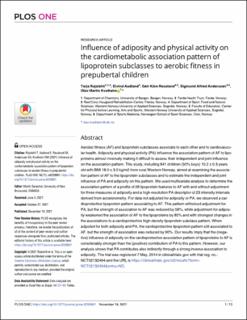| dc.contributor.author | Rajalahti, Tarja | |
| dc.contributor.author | Aadland, Eivind | |
| dc.contributor.author | Resaland, Geir Kåre | |
| dc.contributor.author | Anderssen, Sigmund Alfred | |
| dc.contributor.author | Kvalheim, Olav Martin | |
| dc.date.accessioned | 2021-11-22T09:56:24Z | |
| dc.date.available | 2021-11-22T09:56:24Z | |
| dc.date.created | 2021-11-03T09:35:16Z | |
| dc.date.issued | 2021 | |
| dc.identifier.issn | 1932-6203 | |
| dc.identifier.uri | https://hdl.handle.net/11250/2830660 | |
| dc.description.abstract | Aerobic fitness (AF) and lipoprotein subclasses associate to each other and to cardiovascular health. Adiposity and physical activity (PA) influence the association pattern of AF to lipoproteins almost inversely making it difficult to assess their independent and joint influence on the association pattern. This study, including 841 children (50% boys) 10.2 ± 0.3 years old with BMI 18.0 ± 3.0 kg/m2 from rural Western Norway, aimed at examining the association pattern of AF to the lipoprotein subclasses and to estimate the independent and joint influence of PA and adiposity on this pattern. We used multivariate analysis to determine the association pattern of a profile of 26 lipoprotein features to AF with and without adjustment for three measures of adiposity and a high-resolution PA descriptor of 23 intensity intervals derived from accelerometry. For data not adjusted for adiposity or PA, we observed a cardioprotective lipoprotein pattern associating to AF. This pattern withstood adjustment for PA, but the strength of association to AF was reduced by 58%, while adjustment for adiposity weakened the association of AF to the lipoproteins by 85% and with strongest changes in the associations to a cardioprotective high-density lipoprotein subclass pattern. When adjusted for both adiposity and PA, the cardioprotective lipoprotein pattern still associated to AF, but the strength of association was reduced by 90%. Our results imply that the (negative) influence of adiposity on the cardioprotective association pattern of lipoproteins to AF is considerably stronger than the (positive) contribution of PA to this pattern. However, our analysis shows that PA contributes also indirectly through a strong inverse association to adiposity. | en_US |
| dc.language.iso | eng | en_US |
| dc.publisher | PLoS | en_US |
| dc.rights | Navngivelse 4.0 Internasjonal | * |
| dc.rights.uri | http://creativecommons.org/licenses/by/4.0/deed.no | * |
| dc.title | Influence of adiposity and physical activity on the cardiometabolic association pattern of lipoprotein subclasses to aerobic fitness in prepubertal children | en_US |
| dc.type | Journal article | en_US |
| dc.type | Peer reviewed | en_US |
| dc.description.version | publishedVersion | en_US |
| dc.rights.holder | Copyright 2021 the authors | en_US |
| dc.source.articlenumber | e0259901 | en_US |
| cristin.ispublished | true | |
| cristin.fulltext | original | |
| cristin.qualitycode | 1 | |
| dc.identifier.doi | https://doi.org/10.1371/journal.pone.0259901 | |
| dc.identifier.cristin | 1950848 | |
| dc.source.journal | PLOS ONE | en_US |
| dc.identifier.citation | PLOS ONE. 2021, 16 (11), e0259901. | en_US |
| dc.source.volume | 16 | en_US |
| dc.source.issue | 11 | en_US |

